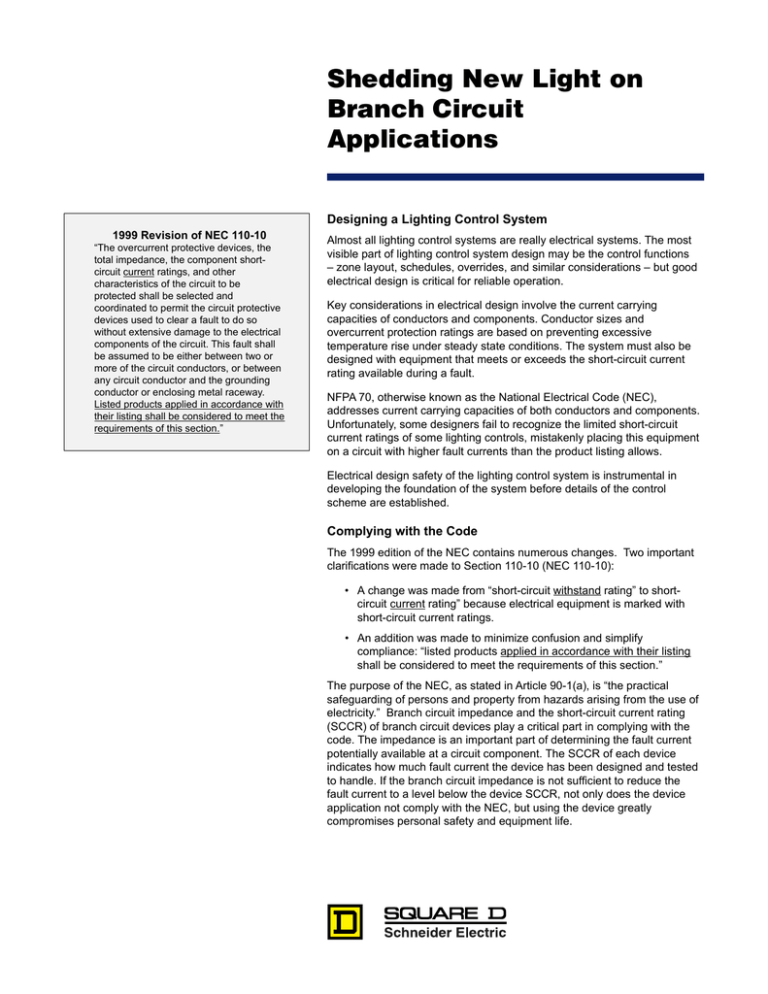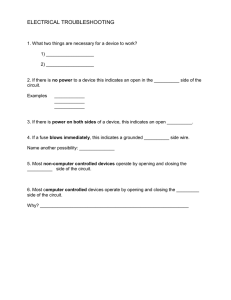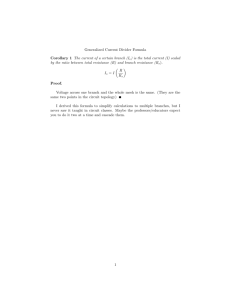
Shedding New Light on
Branch Circuit
Applications
Designing a Lighting Control System
1999 Revision of NEC 110-10
“The overcurrent protective devices, the
total impedance, the component shortcircuit current ratings, and other
characteristics of the circuit to be
protected shall be selected and
coordinated to permit the circuit protective
devices used to clear a fault to do so
without extensive damage to the electrical
components of the circuit. This fault shall
be assumed to be either between two or
more of the circuit conductors, or between
any circuit conductor and the grounding
conductor or enclosing metal raceway.
Listed products applied in accordance with
their listing shall be considered to meet the
requirements of this section.”
Almost all lighting control systems are really electrical systems. The most
visible part of lighting control system design may be the control functions
– zone layout, schedules, overrides, and similar considerations – but good
electrical design is critical for reliable operation.
Key considerations in electrical design involve the current carrying
capacities of conductors and components. Conductor sizes and
overcurrent protection ratings are based on preventing excessive
temperature rise under steady state conditions. The system must also be
designed with equipment that meets or exceeds the short-circuit current
rating available during a fault.
NFPA 70, otherwise known as the National Electrical Code (NEC),
addresses current carrying capacities of both conductors and components.
Unfortunately, some designers fail to recognize the limited short-circuit
current ratings of some lighting controls, mistakenly placing this equipment
on a circuit with higher fault currents than the product listing allows.
Electrical design safety of the lighting control system is instrumental in
developing the foundation of the system before details of the control
scheme are established.
Complying with the Code
The 1999 edition of the NEC contains numerous changes. Two important
clarifications were made to Section 110-10 (NEC 110-10):
• A change was made from “short-circuit withstand rating” to shortcircuit current rating” because electrical equipment is marked with
short-circuit current ratings.
• An addition was made to minimize confusion and simplify
compliance: “listed products applied in accordance with their listing
shall be considered to meet the requirements of this section.”
The purpose of the NEC, as stated in Article 90-1(a), is “the practical
safeguarding of persons and property from hazards arising from the use of
electricity.” Branch circuit impedance and the short-circuit current rating
(SCCR) of branch circuit devices play a critical part in complying with the
code. The impedance is an important part of determining the fault current
potentially available at a circuit component. The SCCR of each device
indicates how much fault current the device has been designed and tested
to handle. If the branch circuit impedance is not sufficient to reduce the
fault current to a level below the device SCCR, not only does the device
application not comply with the NEC, but using the device greatly
compromises personal safety and equipment life.
Shedding New Light on
Branch Circuit Applications
z
Relay/contactor
L
Panelboard
Figure 1 The impedance, Z, varies directly with, L, the
length of the conductor between the panelboard and
the power switching device. As the length decreases,
the impedance decreases and the potential fault
current available at the device increases. Switching
device ratings and circuit layout must be carefully
considered during system design.
480 V Panelboard
14kA Fault Current
Relay/contactor
rated at 1000 A SCCR
Design Considerations – The Problem
Using lighting control as an example, consider the application of relays/
contactors and remotely operated circuit breakers. To specify a code
compliant lighting control system, the designer must know the available
fault current and the SCCR of the manufacturer’s products. The procedure
for determining fault current is found in the Institute of Electrical and
Electronic Engineers (IEEE) Standard 141 or in IEEE Standard 241 (The
Gray Book). The relay/contactor or remotely operated circuit breaker
manufacturer should either display the rating on the product in accordance
with its listing (e.g. UL listing) or provide rating data with the product.
Relays were one of the first solutions for automated lighting control
applications. Years ago, relays were placed at the loads, a substantial
distance from the panelboard. The length of the conductor between the
panelboard and the relay provided sufficient impedance to minimize the
fault current available at the relay. Today, for convenience and
maintainability, relays are located in a central cabinet located next to the
panelboard. Therefore, branch circuit impedance is critical to determining
whether relays meet the required SCCR requirements (see Figure 1). The
shortened conductor length between the panelboard and relay cabinet
decreases the impedance and significantly increases the available fault
current at the relay. Consequently, relay based systems require additional
design considerations to ensure compliance with Section 110-10.
Standard Practices – How to Select Components
UL standards have been established to determine the short-circuit current
ratings for electrical components.
Length of wire between
panelboard and
relay/contactor
Fault current available at
relay/contactor
10 ft
9,808 A
15 ft
8,004 A
20 ft
6,662 A
25 ft
5,665 A
Figure 2 The UL 508 tested relay/contactor is rated
for 1000 A SCCR. When the conductor length between
the panelboard and relay/contactor is 25 ft., the fault
current at the relay/contactor far exceeds the 1000 A
available fault current. This circuit does not comply with
NEC 110-10 for a length of wire less than 25 ft.
480V Panelboard
14kA Fault Current
Relay/contactor
rated at 1000 A SCCR
170 ft
Figure 3 The UL 508 tested relay/contactor is rated at
1000 A. In order to comply with NEC 110-10, the length
of the conductor between the panelboard and relay/
contactor must be 170 ft. to reduce the fault current to
less than 1000 A.
• Basic Requirements – UL 508 and UL 916
Relays/contactors are typically listed under UL 508 – Industrial Control
Equipment. The standard defines a set of tests that establishes a
peformance level at specific fault current levels with a specified branch
circuit protection device. The standard short circuit current test is 1000 A
for relays and contactors rated 1.5 HP and below. Figure 2 illustrates an
installation that is clearly a violation of NEC Section 110-10. Figure 3 is
an example that shows the approximate distance required between the
panelboard and relay/contactor to comply with a 1000 A rating.
Note: Current calculations in Figures 2 through 4 that follow are not
intended for design purposes but for illustration only. The following
assumptions apply: a) copper conductor with THHN/THWN
insulation (X&R data); b) X/R = 5; c) several single conductor
cables in steel conduit; d) calculations based on IEEE Std 1411993; e) 480Y/277 3P 4W f) #12 conductor (20 amp); f) available
fault current at panelboard is 14kA.
UL 916 – Energy Management Equipment is intended primarily for
control panels used with energy management equipment. This standard
also includes a short circuit test but is limited to 1000 symmetrical
amperes for control relays under 1.5 HP. UL 916 does not require
markings for this rating to be on the product or literature.
480V Panelboard
14kA Fault Current
RK5
fuse
Relay/contactor
Length of wire between
Fault current available at
panelboard and
relay/definite purpose contactor relay/definite purpose contactor
10 ft
9,808 A
15 ft
8,004 A
20 ft
6,662 A
25 ft
5,665 A
Figure 4 The UL 508 tested relay/definite purpose
contactor is rated at 5000 A when used with a RK5
fuse. When the conductor length between the
panelboard and the relay/definite purpose contactor is
25 ft., the fault current at the relay/definite purpose
contactor still exceeds the 5000 A rating. This circuit
does not comply with NEC 110-10 for a length of wire
less than 25 ft.
480V Panelboard
with Square D Type EHB
circuit breaker;
14kA Fault Current
Square D
Class 8903
Contactor
Figure 5 Square D Class 8903 Lighting Contactors
are designed specifically for lighting applications.
Evaluated in accordance with UL 508, these lighting
contactors are rated substantially above the standard
1000 A. When used with a Square D Type EHB branch
circuit breaker, the Class 8903 contactor has a certified
rating of 14,000 A – the fault current available at the
panelboard in this example.
480V Panelboard with POWERLINK AS
remotely operated circuit breakers;
14kA Fault Current
POWERLINK AS circuit breaker
contains an integral switching
device
Figure 7 POWERLINK AS remote operated circuit
breakers fit in any conventional breaker panelboard
enclosures. Series connected ratings up to 200,000
rms amperes. UL ratings include HACR, HID, and
SWD.
• Higher Fault Current Testing – UL 508
Listing a device to UL 508 often requires branch circuit protection in order
for the product to pass the test sequence. The overcurrent device,
branch circuit breaker or fuse, is then required to be marked on the
Listed UL 508 device. To meet UL 508 the device must have a minimum
of 1000 A SCCR. Some relays have a 5000 A SCCR when used with an
RK5 fuse. In order to ensure a NEC compliant installation, the relay/
contactor must be installed per the manufacturer’s instructions with the
required circuit breaker or fuse for protection (see Figure 4.)
Square D, a market leading supplier of electrical distribution, industrial
control and automation products, systems and services, offers a code
compliant contactor solution. Square D Class 8903 lighting contactors
provide a time-proven design and are used wherever reliable, convenient
and economical lighting control is required. This line of contactors is
designed and
UL Listed Short-Circuit Rating
intended specifically
Contactors Protected by Fusible Disconnect Switches
for lighting.
Contactor
Maximum
Continuous
Maximum
Available Amperes
Class RK5
Square D lighting
Rating
Voltage
(RMS Sym.)
Fuse Rating
Amps
contactors are
20, 30
30
600
100,000
60
60
600
100,000
tested with both
100
100
600
100,000
200
200
480
100,000
fusible disconnect
300
400
600
100,000
400
400
600
100,000
switches and circuit
Contactors Protected by Circuit Breakers
breakers (see
Contactor
Recommended
Maximum
Available
Continuous
Square D
Maximum
Figure 5). In
Circuit Breaker
Amperes
Rating
Circuit Breaker
Voltage
Rating
Amps
(RMS Sym.)
Amps
Types
addition to the
20
25
EH-EHB, FH-FHL
240
22,000
20
25
EH-EHB, FA-FAL,
480
14,000
product markings
FH-FHL
30
40
FA-FAL, FH-FHL
600
10,000
required under UL
30
40
IF-IFL
480
100,000
60
80
FH-FHL
600
18,000
508, the short circuit
60
90
IF-IFL
480
100,000
100
125
KA-KAL, KH-KHL
600
10,000
current ratings for
100
125
IK-IKL
480
100,000
200
250
LA-LAL, LH-LHL
600
14,000
Square D lighting
200
225
IK-IKL
480
100,000
300
400
LA-LAL, LH-LHL
600
22,000
400
800
MA-MAL, MH-MHL
600
22,000
contactors are fully
600
800
MA-MAL, MH-MHL
600
22,000
disclosed and
Figure
6
Published
ratings
for
Square
D
Class
8903
readily available
Lighting Contactors
(see Figure 6).
• Remotely Operated Circuit Breakers
Remotely operated circuit breakers are designed to switch branch
circuits while providing overcurrent protection and are Listed under UL
489 – Molded Case Circuit Breakers and Enclosures. UL 489 requires
the maximum interrupting rating be displayed on the circuit breaker. The
NEC and UL 489 both indicate the primary function of circuit breakers is
to protect the conductors.
POWERLINK® AS remotely operated circuit breakers from Square D are
another lighting control option. The remotely operated circuit breakers
provide both overcurrent protection and switching functions and fit into
any existing standard panelboard enclosure. No additional wiring or
enclosures are required (see Figure7). Branch circuits can be switched
by a motor operating the breaker contacts. The POWERLINK AS system
offers the capability to control lighting and other loads to preset time
schedules or from external control devices such as wall switches,
occupancy sensors, or building management systems. The breakers are
designed to handle high-inrush current loads and today’s high short
circuit current requirements. Tested under UL 489, UL listed interrupting
ratings are on the circuit breaker and widely published for each type of
POWERLINK AS circuit breaker (see Figure 8). As shown in Figure 9,
series ratings for POWERLINK AS panelboards and remotely operated
circuit breakers are also available.
Shedding New Light on
Branch Circuit Applications
UL Listed Interrupting Ratings for POWERLINK AS Circuit Breakers
Catalog
Number
Prefix
Number
of
Poles
Continuous
Voltage
Current
Rating
Continuous
Maximum
Current
Voltage
Rating
Rating
Ampere
Interrupting
Rating
QO(B)-AS
QO(B)
QO(B)
QO(B)-AS
QO(B)
QO(B)-AS
1
2
3
120/240Vac
120/240Vac
15A,
20A, 30A
240Vac
120/240Vac
15A,
20A, 30A
15A,
20A, 30A
120/240Vac
15A,
20A, 30A
240Vac
10,000A
10,000A
10,000A
EHB
EHB-AS
1
1
120Vac
15A, 20A, 30A
277Vac
120Vac
15A,
20A, 30A
277Vac
65,000A
14,000A
EHB
EHB-AS
2
2
120/240Vac
15A, 20A
480Y/277Vac
120/240Vac
15A, 20A
480Y/277Vac
65,000A
14,000A
EHB
EHB-AS
3
3
240Vac
15A,
20A
480Y/277Vac
240Vac
15A,
20A
480Y/277Vac
65,000A
14,000A
Figure 8 Published ratings for POWERLINK AS remotely
operated circuit breakers.
NQOD Series Ratings
System
UL Series
Voltage Connected Rating
(Maximum)
(AIR)
240Vac
Main
Max.
Amperes
Type
Branch
Type
Amperes Poles
22,000
QO(B)-VH
150
QO-AS
QOB-AS
15-30
15-30
15-30
1
2
3
25,000
KD
250
QO-AS
QOB-AS
15-30
15-30
15-30
1
2
3
FC
100
QO-AS
QOB-AS
15-30
15-30
15-30
1
2
3
KC
250
QO-AS
QOB-AS
15-30
15-30
15-30
1
2
3
FI
100
QO-AS
QOB-AS
15-30
15-30
15-30
1
2
3
100
QO-AS
QOB-AS
15-30
15-30
15-30
1
2
3
100,000
200,000
FI
NEHB Series Ratings
System
UL Series
Voltage Connected Rating
(Maximum)
(AIR)
Main
Max.
Amperes
Type
Branch
Type
FC
100
EHB-AS
15-30
15-20
15-20
1
2
3
KC
250
EHB-AS
15-30
15-20
15-20
1
2
3
FI
100
EHB-AS
15-30
15-20
15-20
1
2
3
15-30
15-20
15-20
15-30
15-20
15-20
1
2
3
1
2
3
65,000
480Y/
277Vac
200,000
100,000
Amperes Poles
KI
250
EHB-AS
Class J/T
Fuse
200
EHB-AS
Figure 9 UL tested and listed series combination
ratings for POWERLINK AS panelboards and remotely
operated circuit breakers. The ratings apply to either an
integral main located in the same enclosure or a
remote main located in a separate enclosure.
Spotting Potential Code Violations
Square D has published ratings for its remotely
operated circuit breakers and Class 8903 lighting
contactors that have been tested and listed. You
must know the short-circuit current rating of the
relay/contactor or the interrupting rating of the
circuit breaker to determine whether the circuit
complies with NEC 110-10. If the ratings are not
marked on or published with the device, you
must contact the manufacturer to verify the
ratings.
Installations that deserve a second look to
confirm compliance with NEC 110-10:
a) Relay/contactor not protected by a branch
short circuit protective device
b) Lighting controls mounted in enclosure
electrically near the panelboard
c) Branch circuit protection that does not match
markings on the relay/contactor
d) UL 916 (Listed Energy Management
Equipment) is on a circuit that exceeds 1000A
of available fault current
e) Lighting contactors are identified as Definite
Purpose
Summary
The clarifications in Section 110-10 of the 1999
NEC have significant impact on the safe
application of branch circuit components.
Individual devices may meet the appropriate test
standards required for the device, but more
importantly, all elements of the branch circuit –
overcurrent protective devices, total impedance,
short-circuit current ratings – must be selected to
permit the protective devices to clear a fault
without extensive damage to the circuit
components.
If any component of the branch circuit cannot
meet the available fault current, the circuit does
not meet code requirements. Concerns for
personal safety, reliability, and equipment
damage warrant a close examination of common
branch circuit switching and protection
applications.
POWERLINK, Square D, and
are registered trademarks of
Square D Company or related companies.
Bulletin No. 1210HO9901
May 1999
© 1999 Square D All Rights Reserved


